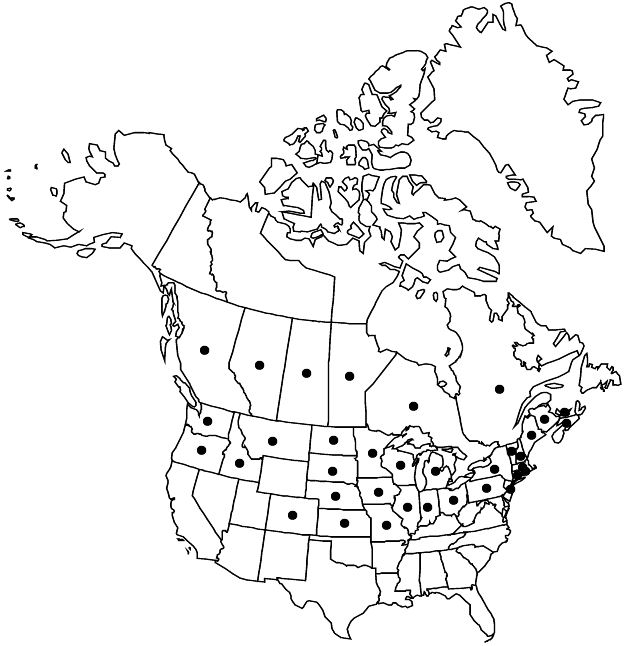Difference between revisions of "Hypericum majus"
Mem. Torrey Bot. Club 5: 225. 1894.
FNA>Volume Importer |
imported>Volume Importer |
||
| (6 intermediate revisions by 2 users not shown) | |||
| Line 12: | Line 12: | ||
|label=Endemic | |label=Endemic | ||
}} | }} | ||
| − | |basionyms={{Treatment/ID/ | + | |basionyms={{Treatment/ID/Basionym |
|name=Hypericum canadense var. majus | |name=Hypericum canadense var. majus | ||
|authority=A. Gray | |authority=A. Gray | ||
| + | |rank=variety | ||
| + | |publication_title=Manual ed. | ||
| + | |publication_place=5, 86. 1867 (as major) | ||
}} | }} | ||
|synonyms={{Treatment/ID/Synonym | |synonyms={{Treatment/ID/Synonym | ||
|name=H. mutilum var. longifolium | |name=H. mutilum var. longifolium | ||
|authority=R. Keller | |authority=R. Keller | ||
| − | }}{{Treatment/ID/Synonym | + | |rank=variety |
| + | }} {{Treatment/ID/Synonym | ||
|name=Sarothra major | |name=Sarothra major | ||
|authority=(A. Gray) Y. Kimura | |authority=(A. Gray) Y. Kimura | ||
| + | |rank=species | ||
}} | }} | ||
|hierarchy=Hypericaceae;Hypericum;Hypericum sect. Brathys;Hypericum majus | |hierarchy=Hypericaceae;Hypericum;Hypericum sect. Brathys;Hypericum majus | ||
| Line 37: | Line 42: | ||
|elevation=0–1200 m | |elevation=0–1200 m | ||
|distribution=Alta.;B.C.;Man.;N.B.;N.S.;Ont.;P.E.I.;Que.;Sask.;Colo.;Conn.;Idaho;Ill.;Ind.;Iowa;Kans.;Maine;Mass.;Mich.;Minn.;Mo.;Mont.;Nebr.;N.H.;N.J.;N.Y.;N.Dak.;Ohio;Oreg.;Pa.;R.I.;S.Dak.;Vt.;Wash.;Wis.;introduced in Europe (France;Germany);e Asia (Japan). | |distribution=Alta.;B.C.;Man.;N.B.;N.S.;Ont.;P.E.I.;Que.;Sask.;Colo.;Conn.;Idaho;Ill.;Ind.;Iowa;Kans.;Maine;Mass.;Mich.;Minn.;Mo.;Mont.;Nebr.;N.H.;N.J.;N.Y.;N.Dak.;Ohio;Oreg.;Pa.;R.I.;S.Dak.;Vt.;Wash.;Wis.;introduced in Europe (France;Germany);e Asia (Japan). | ||
| − | |discussion=<p>Hypericum majus was the western member of a vicariant species pair, differing from the originally eastern member (H. canadense) by the broader leaves, usually more-congested inflorescence, and larger flowers. These species became sympatric in glaciated northeastern North America and now hybridize freely, notably in Wisconsin (F. H. Utech and H. H. Iltis 1970). Hybrids are intermediate in form between the parents and have also been recorded from Connecticut, Massachusetts, and New Hampshire. Hypericum majus hybridizes also with H. mutilum, with subsp. mutilum in Maine, and with subsp. boreale in Michigan and Wisconsin.</p> | + | |discussion=<p><i>Hypericum majus</i> was the western member of a vicariant species pair, differing from the originally eastern member (<i>H. canadense</i>) by the broader leaves, usually more-congested inflorescence, and larger flowers. These species became sympatric in glaciated northeastern North America and now hybridize freely, notably in Wisconsin (F. H. Utech and H. H. Iltis 1970). Hybrids are intermediate in form between the parents and have also been recorded from Connecticut, Massachusetts, and New Hampshire. <i>Hypericum majus</i> hybridizes also with <i>H. mutilum</i>, with <i></i>subsp.<i> mutilum</i> in Maine, and with <i></i>subsp.<i> boreale</i> in Michigan and Wisconsin.</p> |
|tables= | |tables= | ||
|references= | |references= | ||
| Line 46: | Line 51: | ||
-->{{#Taxon: | -->{{#Taxon: | ||
name=Hypericum majus | name=Hypericum majus | ||
| − | |||
|authority=(A. Gray) Britton | |authority=(A. Gray) Britton | ||
|rank=species | |rank=species | ||
| Line 61: | Line 65: | ||
|publication year=1894 | |publication year=1894 | ||
|special status=Endemic | |special status=Endemic | ||
| − | |source xml=https:// | + | |source xml=https://bitbucket.org/aafc-mbb/fna-data-curation/src/2e0870ddd59836b60bcf96646a41e87ea5a5943a/coarse_grained_fna_xml/V6/V6_155.xml |
|genus=Hypericum | |genus=Hypericum | ||
|section=Hypericum sect. Brathys | |section=Hypericum sect. Brathys | ||
Latest revision as of 22:19, 5 November 2020
Herbs perennial, erect, branching at base and in inflorescence, branches relatively few, 0.5–7 dm. Stems: internodes 4-angled. Leaves spreading, sessile or distal subamplexicaul; blade lanceolate to narrowly oblong-elliptic or (proximal) oblanceolate, 10–45 × (2–)6–12 mm, papery to membranous, margins plane, apex acute to rounded, basal or near-basal veins (3–)5–7, midrib with to 4 pairs of branches. Inflorescences corymbiform to cylindric, 3–30-flowered, usually compact, branching mostly dichasial. Flowers 6–7 mm diam.; sepals lanceolate to narrowly elliptic, equal, 3.5–6.5 × 0.8–1.5 mm, margins sometimes ciliate, not setulose-ciliate, apex acute; petals golden yellow, sometimes red-veined, oblanceolate, 3.5–6 mm; stamens 12–21, obscurely 5-fascicled; styles 0.6–1 mm; stigmas broadly capitate. Capsules narrowly conic-ellipsoid, 4–8 × 2.5–3.5 mm, broadest proximal to middle. Seeds 0.5–0.7 mm; testa finely linear-scalariform. 2n = 16.
Phenology: Flowering summer (Jun–Sep).
Habitat: Fens, marshes, ditches, lake and stream margins, other damp habitats
Elevation: 0–1200 m
Distribution

Alta., B.C., Man., N.B., N.S., Ont., P.E.I., Que., Sask., Colo., Conn., Idaho, Ill., Ind., Iowa, Kans., Maine, Mass., Mich., Minn., Mo., Mont., Nebr., N.H., N.J., N.Y., N.Dak., Ohio, Oreg., Pa., R.I., S.Dak., Vt., Wash., Wis., introduced in Europe (France, Germany), e Asia (Japan).
Discussion
Hypericum majus was the western member of a vicariant species pair, differing from the originally eastern member (H. canadense) by the broader leaves, usually more-congested inflorescence, and larger flowers. These species became sympatric in glaciated northeastern North America and now hybridize freely, notably in Wisconsin (F. H. Utech and H. H. Iltis 1970). Hybrids are intermediate in form between the parents and have also been recorded from Connecticut, Massachusetts, and New Hampshire. Hypericum majus hybridizes also with H. mutilum, with subsp. mutilum in Maine, and with subsp. boreale in Michigan and Wisconsin.
Selected References
None.